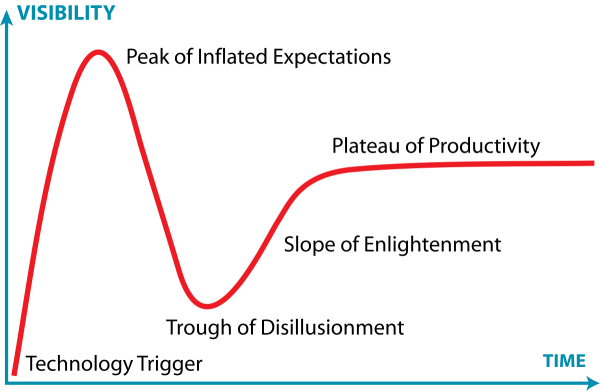 By Brock Aun
By Brock Aun
Vice President, Communications and Public Policy
HAAS Alert
Vehicle-to-everything (V2X) technology has long hovered on the horizon — a vision of cars that communicate with each other, with infrastructure, with pedestrians, and with the digital world to make driving safer, smarter, and more efficient.
But like so many promising technologies, V2X hasn’t had a smooth journey.
 In 1995, Gartner analyst Jackie Fenn introduced a concept that would ultimately become a cornerstone of tech forecasting: the Hype Cycle. It outlines five key phases that every transformative technology passes through:
In 1995, Gartner analyst Jackie Fenn introduced a concept that would ultimately become a cornerstone of tech forecasting: the Hype Cycle. It outlines five key phases that every transformative technology passes through:
- The Technology Trigger — when innovation sparks attention
- The Peak of Inflated Expectations — when enthusiasm outpaces practicality
- The Trough of Disillusionment — when early challenges lead to skepticism
- The Slope of Enlightenment — when real-world value becomes visible
- The Plateau of Productivity — when adoption becomes widespread and normalized
For much of the past two decades, V2X has been stuck in the Trough of Disillusionment. After early excitement around the concept of a fully connected transportation system, real-world adoption stalled. Infrastructure funding and deployments lagged. Technology standards fractured as new forms of connectivity emerged. All the while, consumer awareness remained low. For many, V2X became a footnote to more glamorous pursuits like self-driving cars and electrification.
But that’s changing — fast.
A breakthrough in understanding what drivers actually want
This month, groundbreaking research from POCO Labs, in collaboration with Mcity and SAE International, marks a critical turning point. In the most comprehensive U.S. study to date on V2X perception, thousands of consumers sent a clear message: They want connected vehicle technology — especially when it makes them safer.
Far from niche or theoretical, V2X safety features are now a mainstream expectation:
- 87% of drivers rate real-time road hazard warnings as a “must-have” or “nice-to-have” feature
- 93% see significant value in receiving alerts about incidents on the road
- 88% want the functionality built into the vehicle itself — no smartphone dependency
- Resistance is negligible: Just 4% of drivers say they don’t want hazard warnings
Specific types of hazard alerts, like emergency vehicle notifications, pedestrian alerts, and work zone alerts, also ranked highly, especially among younger drivers and those navigating urban environments.
A generational shift and a competitive wake-up call
Most remarkably, the demand for connected safety features is strongest among younger generations: 43% of Gen Z drivers rate emergency vehicle warnings as a “must-have” feature for a new car, compared to just 14% of Boomers. These are tomorrow’s buyers — and they’re demanding cars that don’t just move, but communicate.
The media, however, is still focused on the hype around other emerging vehicle technologies, despite major consumer skepticism and concerns. Autonomous vehicles dominate the news coverage, for instance, even though 6 in 10 drivers are afraid to ride in a self-driving vehicle and only 13% of drivers say they would trust a self-driving vehicle (down from 18% in 2022). Similarly, while electric vehicles are growing in viability and popularity, only 34% of drivers surveyed recently said they planned to buy an electric vehicle in the next 24 months.
That’s right: Less than 1 in 10 drivers trusts self-driving cars, and 1 in 3 drivers intends to buy an electric vehicle. But over 8 in 10 drivers want their vehicle connected and capable of receiving safety messages. That’s a staggering insight. For all the hype around autonomy and electrification, it’s V2X that drivers see as most immediately valuable technology in their daily lives.
This is the Slope of Enlightenment — the moment when technology transitions from novelty to necessity.
From research to reality: What’s next for OEMs?
The implications in this research for automakers are profound. Consumers no longer view V2X-enabled safety features as a luxury or a bonus. They view them as the new standard — as fundamental to the driving experience as seat belts or airbags. Automakers who integrate these features natively, independently of third-party devices, will not only meet consumer expectations but lead the next wave of automotive innovation. Those who wait may find themselves trailing not just in technology, but in trust, especially because some automakers are already acting.
In 2022, Stellantis became the first automaker to launch digital alerts — a form of V2X road hazard notifications — from emergency vehicles, tow trucks, and other alerting fleets. These notifications, delivered from HAAS Alert’s connected vehicle platform Safety Cloud, are available in millions of Stellantis vehicles on the road today including 2018 and newer Jeep, Dodge, RAM, and Chrysler vehicles. Last November, Volkswagen followed suit, launching hazard alerts in 2024 and newer vehicles in the United States. Mercedes-Benz also piloted digital alerts late last year as part of its Beta program, giving some drivers a preview of what a map-based digital alerting experience might look like in the future.
Most importantly, automakers have a clearer pathway to launching consumer-optimized V2X features than ever before. Previous attempts at launching V2X relied exclusively on the deployment of direct V2X, which requires extensive infrastructure investment anywhere that cars operate. Today, thanks to new advances in network V2X and evolution in federal standards, automakers and infrastructure owner-operators are able to use cellular connectivity to send and receive safety information.
A new reality, not a future fantasy
V2X isn’t waiting in the wings anymore. It’s ready for prime time, and the public is more than ready to embrace it. The vision is now backed by momentum — from technology, from key stakeholders, and most importantly, from real-world demand.
When you know the road ahead is clear, you can move forward with confidence. As an industry, it’s time for automakers to do exactly that.
Signup For The Bike Lane Newsletter
